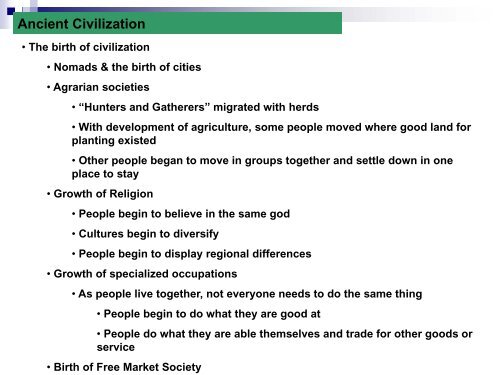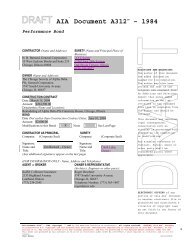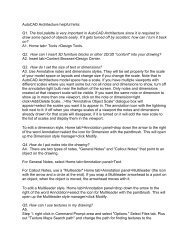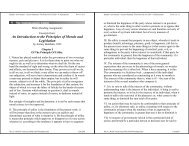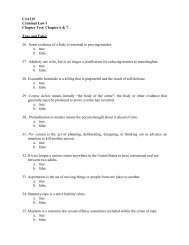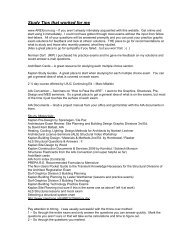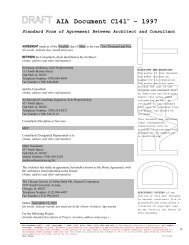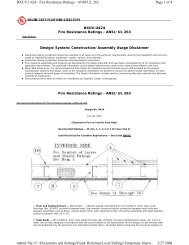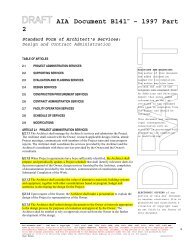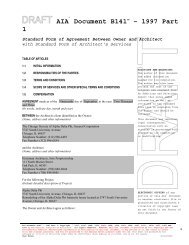Ancient Civilization
Ancient Civilization
Ancient Civilization
You also want an ePaper? Increase the reach of your titles
YUMPU automatically turns print PDFs into web optimized ePapers that Google loves.
<strong>Ancient</strong> <strong>Civilization</strong>• The birth of civilization• Nomads & the birth of cities• Agrarian societies• “Hunters and Gatherers” migrated with herds• With development of agriculture, some people moved where good land forplanting existed• Other people began to move in groups together and settle down in oneplace to stay• Growth of Religion• People begin to believe in the same god• Cultures begin to diversify• People begin to display regional differences• Growth of specialized occupations• As people live together, not everyone needs to do the same thing• People begin to do what they are good at• People do what they are able themselves and trade for other goods orservice• Birth of Free Market Society
<strong>Ancient</strong> <strong>Civilization</strong>• Age of Enlightenment•Study the stars and chart their movement• Advanced Math Skills• Applying science to design• Use of geometries to create monumental buildings• Building placement determined by path of sun or stars on specific days• Ability to build monumental structures with simple machines• <strong>Civilization</strong>s in Contact?• There are studies that suggest the Egyptians and Pre-Incans made contact longbefore the Vikings came to the Western hemisphere• Similar architecture• Similar tools• Most Importantly artifacts found in Egypt made of materials that only exist inSouth America
<strong>Ancient</strong> <strong>Civilization</strong>• Middle Eastern Culture• Catal Huyuk 6000 bcLocated it what is now Modern Day Turkey, thiscomplex shows what early settlements were like.This complex provided shelter and security.This two story complex also through the use ofits stairs provided a rudimentary means of AirConditioning by forcing warm air downwardthrough their stair towers results in dropping airtemperature and cooling of the interior spaces.The complex is communal by nature. All theresidents share a common bread oven andcommon court yards. There is a commonreligious space for all to come and worship.Mankind settled down and grouped together toprovide support for one another for safety.With the rise of complexes such as these, thenomadic man who used to fend for himself nowcould specialize in what he did best to supportthe group. Thus starting specialized trades andcreating a jumpstart for commerce.Plan of huyuk
<strong>Ancient</strong> <strong>Civilization</strong>• Stonehenge• Approx. 2750 bcCeltic people practicing the druid religionbuilt this immense stone structure for rituals.No one is very sure as to what the intent wasfor this work. There is no clue to whether ithad an animal hide tent roof or not. There isno proof that it had any covering whatsoever.What we do know this is a very difficultstructure to build with the technology of thetime. Structures like these show how peoplewere tied to the sky and charting out the sun& stars. This arrangement of stones is ahuge calendar. One thing we must realize isthat ancients civilizations had developedsuperior math skills to be able to chart &align these massive stones to follow thesenatural patterns. This told them when thesolstices would occur as well as solar andlunar eclipses.
<strong>Ancient</strong> <strong>Civilization</strong>• Basic StructuresBasic structures as teepees and wigwamswere developed by aboriginal people due tothe fact they needed shelter from theelements. At first the structures wererudimentary. But as cultures developed theybecame more complex.Basic structures of aboriginal people are verymuch ephemeral. All items found are naturalin their inception. This teepee is made fromanimal hides and tree branches. The ropesholding it together are made from the fibersof plants and trees. Aboriginal people tendto make the most out of the naturalenvironment, finding a use for every part ofan animal or plant in order to make their liveseasier.Since these are utilitarian structures, the waythey added design was by the use of rugsand wall coverings. These colorful rugswould show status, tribe, & wealth.Basic teepee
<strong>Ancient</strong> <strong>Civilization</strong>• Egyptian CultureLike many civilizations of ancient times, theEgyptians were based around water. Therecivilization grew along the Nile stretchingfrom the Mediterranean down to present daySudan. Their people were Arabic and Nubian.The were the best navigators of their time.They were successful farmers and cultivatedthe flood plains and deltas for cotton andgrains. Since they were such a water-basedculture, elements of their surroundings cameinto their architecture.At the same time the Egyptians, weresurrounded by deserts and rock cliffs. Theyquarried these cliffs for sandstone andgranite to use for their monumentalarchitecture. They used the mud from theswamps to make bricks for their utilitarianarchitecture. Trees were scarce. What woodwas available was used for simple structures( palm trees ) and for high-end Furniture (ebony ).Egyptian columns
<strong>Ancient</strong> <strong>Civilization</strong>• Egyptian CultureEgyptian civilization was a feudal system.They were ruled by kings or Pharaohs.These Pharaohs were believed by theirfollowers to be the descendants of gods.They would join their parents and gods in theafterlife to reign once again.This chair belonged to Tutankhamun or KingTut as we know him. Although he is wellknown, the boy king was a lesser king. He iswell know because his tomb was found inThebes, the ancient capital of Egypt,perfectly intact. This allowed us to reallyexplore the culture. Before that other tombshad been found but raiders often got to themfirst depleting the riches thus stealinginformation from those who wanted tounderstand the culture.This chair is a combination of Ebony, Gold,Flax Linen and precious stones. Thesematerials were in common use for royalty andthe upper classes.Chair of Tutankhamun
<strong>Ancient</strong> <strong>Civilization</strong>• Egyptian CultureThe burial chamber of King Tut was discovered by two Englisharcheologist in 1922. Much to their fortune this tomb had not beenraided in the past. Nicholas Carter and Lord Carnarvon took eightyears to catalog the tomb and transport their discovery to England.Much to our good Fortune, Carter photographed the whole process.Below is the photo of the Dig in Dierel Bahri the valley of the kings. And tothe right is the photo of theantechamber as it had been left.Burial chamber of TutankhamunPictures and information from the Egyptian StateInformation Service – www.sis.eg
<strong>Ancient</strong> <strong>Civilization</strong>• Egyptian CultureKing Tutankhamun was Pharaoh in the 18 thDynasty of Egypt. It was believed he waskilled by either his spiritual advisor or hisarmy general.In the antechamber we see that it was a roomdedicated for the storage of needed things inthe afterlife. Egyptian culture had strongbeliefs in the afterlife and that it was acivilization not unlike the living world exceptthat Osiris was the king of the dead. Theartifacts showed there was a wooden shrine,boats, a dog, and other daily objects neededto sustain a normal life.antechamber of TutankhamunPictures and information from the Egyptian StateInformation Service – www.sis.eg
<strong>Ancient</strong> <strong>Civilization</strong>• Egyptian CultureIn the Burial Chamber, we find threesarcophaguses and a gold coffin for thebody. The walls are adorned with pictures ofthe procession that brought Tut to his restingspot. These paintings depict Tut as thehuman personification of Osiris. They showthe newly crowned Pharaoh Ayeadministering the “ceremony of the openMouth” which is to allow Tut to come back tolife in the world of the dead. The paintingsshow Tut’s wife, Ankhespaton take part in theceremonies. She went on to marry the newlycrowned Pharaoh Aye. The paintings alsodepict his journey in the night to the kingdomof the dead. Tut is shown passing 12 deitieswith the faces of baboons.The sarcophaguses were made of quartzitestone and were adorned with Sculpturedepicting various gods and hieroglyphics. Inmost cases hieroglyphics on coffins andsarcophaguses were telling of great cursesthat would haunt you if you disturbed thepharaoh’s resting spots.Burial chamber of TutankhamunPictures and information from the Egyptian StateInformation Service – www.sis.eg
<strong>Ancient</strong> <strong>Civilization</strong>• Egyptian CultureOne of the great Engineeringfeats of the Egyptians was thebuilding of the Great Pyramidsat Giza. This is the pyramid ofCheops ( also known as thepyramid of Khufu). Thepyramids were calculated tobe perfect. The pyramids wereto house the burial chambersof the Pharaoh Khufu. Thepyramid itself is 482 feet highand 760 feet square. Thepyramid changed midconstruction.No one knowswhy but it is believed thechange was for the fear theburial chamber could notwithstand the pressure at thebase or the pyramid so theymoved it up into the mass.Section thru CheopsThe burial chamber was 34 ½ feet long by 17 feetwide and 19 feet tall. Like Tutankhamun’s tomb ithoused the items and wealth needed to survivethe afterlife. The triangular shape of the chamberis an engineering marvel. The triangle is thestrongest structural form thus helping deflect theweight of the pyramid above to the sides of thechamber thus preventing it from collapse. Theinterior was adorned with the same type ofpaintings depicting the journey to the afterlifeand the gods attending the ritual ceremonies.Section thru Cheops
<strong>Ancient</strong> <strong>Civilization</strong>• Egyptian CultureHere the Tomb of Pa-Schedu in Thebes, 1500BC, we see paintings of Anubis god of the dead.The paintings are an homage to Anubis andother deities while the hieroglyphics on theceilings depict of mysticism. This tomb showsthe colors used in the interiors. Walls werepainted gold with blues and reds. The colorswere intense. The furniture was often gilded withgold. The sarcophaguses were cut from graniteor other quartzite stones. The walls & floorswere of sandstone.Tomb of Pa-Schedu
<strong>Ancient</strong> <strong>Civilization</strong>• Egyptian CultureThe Temple of Karnak was one of the walledcomplexes that made up the religious section ofThebes. The other was Luxor. The two wereconnected by a boulevard lined with Sphinxes oneither side. The walled complex at Karnak housedtemples to Amun ( the sun god ) and the temples ofKhons and Ptah, his son’s.The temple of Khons is seen as one of the moreideal structures to study. The temple was a churchfor the living. The arrangements were a series ofhypostyle (“many columned”) halls that wereseparated from one another by large pylons, whichare thick tapering walls with ceremonial entrances.Each hall had a principal and transverse axis.Therefore each room functioned on its own ortogether as a group.Section thru the Temple of Khons at Karnak
<strong>Ancient</strong> <strong>Civilization</strong>• Egyptian CultureSection of Hypostyle hall, temple of amun atKarnakThe complex was built from indigenoussandstone. The Columns were carved in basrelief with hieroglyphics and they used closedpapyrus bud capitals on the sides and openpapyrus bud capitals along the principal axis.Hypostyle hall, temple of amun at Karnak
<strong>Ancient</strong> <strong>Civilization</strong>• Egyptian Culture• Temple of Amun at Karnak 1290 BCThe reason that hypostyle halls had such narrowcolumn spacing is due to the maximum span ofthe stone beams between columns, as well asthe magisterial effect such close spacing brings.The native sandstone used for columns andbeams is a relatively soft and weak stone. Woodpurlins used to span the stone beams were palmtrees or cypress. Such trees are not tall enoughto be able to use to span large distances.The hypostyle halls were meant to dwarf people.The Gods for which they were built wereconsidered larger the life. So they neededGrand temples to demonstrate this.Hypostyle Hall, Temple of Amun
<strong>Ancient</strong> <strong>Civilization</strong>• Mediterranean Culture• Knossos, Crete 1500 BCOnce considered the home to the minotaur and King Minos whotouch could turn objects golden, Knossos was the capital of theMycenaean people on the Isle of Crete. This civilization on Cretewas relaxed and luxurious protected from the outside world by thesea. It housed the home for King Minos as well as the religiousfunctions for the city.Plan of huyuk
<strong>Ancient</strong> <strong>Civilization</strong>• Mediterranean Culture• Knossos, Crete 1500 BCThe exterior and interior bleed togetherthrough the use of terraces, covered anduncovered. The Covered terraces blockedthe southern sun again not allowing directlighting, and also allowing air to coolbefore entering the palace. This in turnkept the stone floors cool all day andnight. The Mycenaean people understoodthe climate and how to adapt theirbuildings to maximize their comfort.Throne RoomThe walls were elaborately painted with frescoes ofscenic views such as the beach or the mountains.This palace was not monumental. It was more artisticand scenic offering comfort over pretension. Wood andgypsum were used for walls and columns. Natural Lightcame from light wells from the lightweight wood roofs.The natural light provided an indirect glow to the walls,which was more peaceful than direct lighting.Queens Megaron
<strong>Ancient</strong> <strong>Civilization</strong>• Mediterranean Culture• Knossos, Crete 1500 BCThe Mycenaean people were morewarriors than traders. They didnot like dealing with the outsideworld and defended their landfiercely. They were able to providefor themselves and this allowedthem to develop culturally with artand theater as well as music andliterature.The Mycenaean culture wasalmost completely obliteratedaround the years 1400 – 1100 BCE.It is believed this was a period ofheavy seismic and volcanicactivity for the Greek Isles. Theearthquakes and volcanoes forcedthe inhabitants to mainland Greeceand Turkey. This led to the rise ofKing Agamemnon of Mycenae.This period was the dark ages ofthe Greek world from which therise of the Greek Empire wouldcome.Palace of knossos


